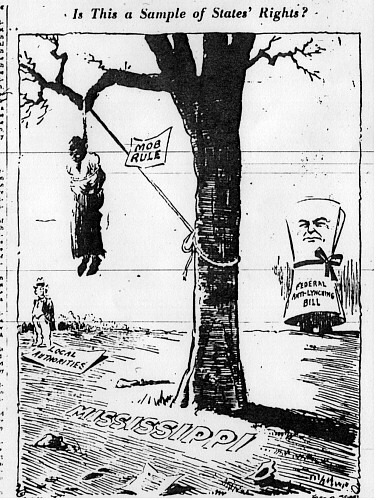"Is This a Sample of States' Rights?"
By Landon Burkhart
This political cartoon was constructed by John Mitchell, Jr. in 1938. The African American had established his own newspaper in Richmond, Virginia called The Richmond Planet. The black lady hanging is a woman who lives in Mississippi where mobs have taken the law into their own hands. The man and scroll watching the lynch that already happened represent two different crowds. The man symbolizes the public local authority and his little to no commitment in bettering the situation. The scroll represents the Federal Anti-Lynching Bill that was passed in 1922 with little enforcement.
The mobsters that were involved in the illegal allegations of lynching were to be treated as any other equal American, by punishment in a court of law; However, the means of getting caught were contradicted by state and local lack of law enforcement.
The abundant Black social class had been intensely targeted by paramilitary, local citizens, and law enforcers in the South. Once the Reconstruction era ended, so did the humanity for black citizens during the time of 1874 to 1940. All Black individuals were subject to violence of the lynching era. The catastrophic event was on the rise in the early 20th century, greatly in the South. The hate crimes done unto the black population, depicted in the cartoon, was mostly associated with Mississippi, Georgia and Alabama. The lynchings usually consisted of black individuals who were accused of rape and assault towards white citizens. It also held abolitionists and any peoples aiding in freeing slaves liable. This was an attempt to scare, demoralize, and temper with the economic, political, and social standing of the Black American
The tree is representing the state of Mississippi, in which holds state authority responsible for a black woman held at the neck. As illustrated, the state and local authorities who carry out the law were also the ones allowing the mob rule to be non-existent. The towns throughout the state led hangings and continued even after the Anti-Lynching Bill was passed. The question, “Is this a Sample of States’ rights?” draws ties to how the South was dealing with the new bill. The bill was not relevant to local paramilitary officials. The reason crime skyrocketed was due to the invincibility and permissiveness of the slaughters done unto the black population. It is argued that because of the economy market for cotton and other raw materials that had crashed, the income became stagnant increasing the white rate of crime.
The mob rule found a niche in the constitution just as the constitution had laws that allowed for transitioning back to slavery [imprisonment] if dealt a crime. The hangings started decreasing into the years of the 1940s. As crimes become less serious and crowds lost interest of the common pain thrusted upon black citizens, the act of lynching slowly faded away.
“Under the direction of the courageous Mitchell, the Planet grew in influence and prestige. The political rights of the American Negro were fearlessly and unflinchingly championed. Lynching was fought and lynchers were defied....Neither threat of violence nor punishment, neither lure of reward nor favor, deterred nor turned this matchless defender of his race from his chosen course.” [Richmond Planet, 5/28/1938]
Primary Source:
Mitchell Jr., John. “The Richmond Planet: Lynch Law Must Go” The Library of Virginia. Accessed April 17, 2015. http://www.lva.virginia.gov/exhibits/mitchell/lynch1.htm
Secondary Source:
Litwack, Leon F. “Hellhounds,”Sources, accessed April 17, 2015, http://historymaking.org/admin/items/show/9.
Stephens, Judith. "'And Yet They Paused" and" A Bill to Be Passed:' Newly Recovered Lynching Dramas by Georgia Douglas Johnson." African American Review (1999): 519-5
